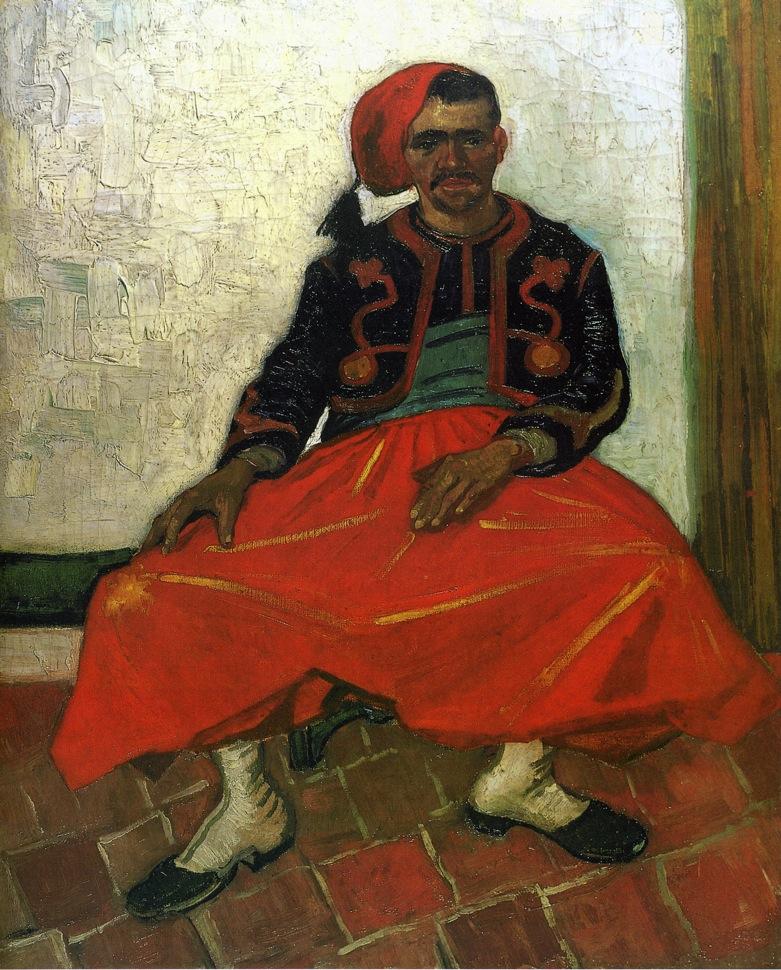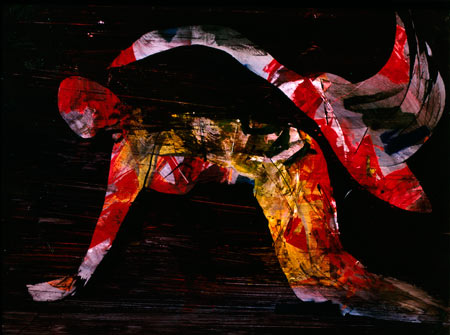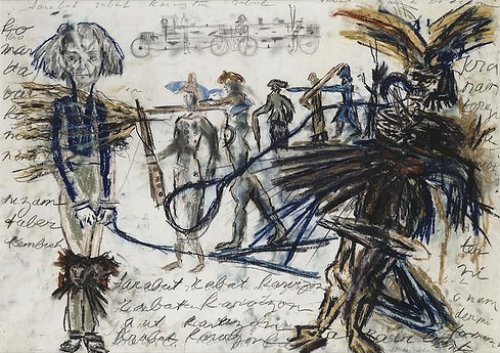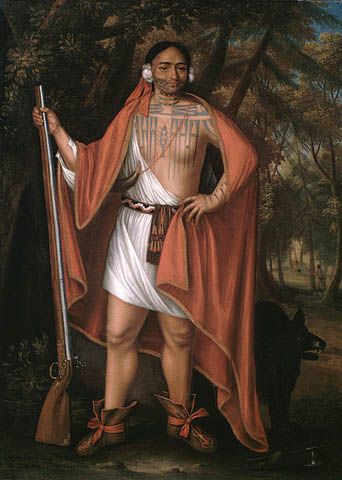The power of color. Is color more a presence than a sign, a force, ” the most sacred element of all visible things.” Is color primary and not secondary to form? Is color fundamentally involved in the making of culture from the human body, or, do colors also “spur us to philosophize” as Wittgenstein said.

---Van Gogh, Vincent (1853-1890) The Seated Zouave Date: 1888 --- Read More:http://www.terminartors.com/artworkprofile/Van_Gogh_Vincent-The_Seated_Zouave
from Michael Taussig:
Wandering through the darkened streets of Paris one night in 1916, about the time the Frenchmen were losing their red trousers, the narrator in Marcel Proust’s In Search of Lost Time happened across a gay friend, the Baron Charlus, surreptitiously eyeing the passing troops. The narrator thought the marvelous display of color must have been similar to the passing of the troops in Napoleon’s time exactly one hundred years before in the same place: “the Africans in their red divided skirts, the Indians in their white turbans were enough to transform for me this Paris through which I was walking into a whole imaginary exotic city, an oriental scene.” By African, he meant the Berbers from Algeria known as zouaves, one of whom was painted in blue, orange, yellow, and black by Vincent van Gogh in Arles in 1888 using oils so as to heighten what he called “the savage combination of incongruous tones,” the zouaves being French infantrymen famous, so it is said, for their brilliant uniform and quick-spirited drill.

Sidney Nolan. Leda and the Swan. Artaud:The work is not a goal to be attained, but a means. So what counts more than anything else is the expression it transmits, either that of a certain maturity of an art or the secret vital palpitation of a model. "The subject matters little, like the object. What matters is the expression, not the expression of the object, but of a certain ideal of the artist, of a certain sum of humanity expressed in colors and lines. Read More:http://www.ciasonhar.org.br/PDFS/the_secret_art_of_Artaud.pdf image:http://theanimalarium.blogspot.com/2010/12/ledas-lover.html
That they go together, these quick spirits and brilliant colors, should not be lost on us. Isidore of Seville, the savants’ savant, said in the seventh century AD that color and heat were the same since colors came from fire or sunlight and because the words for them were fundamentally the same, calor and color. Etymology like this is hardly a science, but he was onto something important, same as the famous connection between color and the quick-spirited drill of the Berbers incorporated into the colonial army. And note that in his Etymologiae Isidore of Seville did not say light, but sunlight, light that comes from the biggest fire of all, the one that gives without receiving.
Talking to Primo Levi, famous for his memoir of Auschwitz, the American novelist Philip Roth suggested that his imprisonment was in some sense a gift. Levi replied: “A friend of mine, an excellent doctor, told me many years ago: ‘Your remembrances of before and after are in black and white; those of Auschwitz and of your travel home are in Technicolor.’ He was right. Family, home, factory, these are good things in themselves, but they deprived me of something I still miss: adventure.”…

---This helps me understand why Burroughs is drawn to color as an organic entity, alive and intimately related to the human body. His writing oozes color that serves him as an agent of metamorphosis. In this regard he is similar, it seems to me, to a Ndembu ritualist, tapping into rivers of color, making and remaking culture from bodily fluids and processes except that Burroughs’s idea of metamorphosis is sardonic and revolutionary.--- Read More:http://www.press.uchicago.edu/Misc/Chicago/790060.html image:http://www.allenginsberg.org/index.php?page=william-burroughs-philip-whalen
Being a chemical engineer, Levi survived because he worked as a slave in the Chemical Komando in the factory set up at Auschwitz by IG Farben, the largest chemical corporation in the world, making everything from toothbrushes to the poison gas used for the final solution. Farben means colors, and it was the search for dazzling, standardized colors that in the mid-nineteenth century led to the new science of organic chemistry from which emerged a world of commodities beyond even the dreams of Faust, just as it was these same dazzling, standardized colors that gave the final spit and polish to what Karl Marx saw as the spirit-like character of the commodity….

Antonin Artaud:It is not without interest to note that Antonin Artaud will declare himself subsequently to have died at Ville-Evrard in August 1939, thus shortly after the casting of the spells -- and there is no doubt that one of their goals is to protect him against disappearance, to affirm his combative will: The goal of all these figures drawn and colored was an exorcism of malediction, a bodily vituperation against the obligations of spatial form, of perspective, of measure, of balance, of dimension, and, through this vindictive vituperation, a condemnation of the psychic world encrusted like a louse on the physical world that it incubuses or succubuses while claiming to have formed it. These strange objects, Antonin Artaud lets it be understood, these kinds of amulet also have a curative function, counteracting an unhealthy power that the psychic wields over the physical. Like their offensive powers, their defensive powers are evident, suffused with the energy of their fabrication, the violence of their intentions, their devastating effects. Plunged into the world of magic spells, we can scarcely escape these flames which, from all sides, lick at the tranquil and comfortable space where we would like to remain.--- Read More:http://www.ciasonhar.org.br/PDFS/the_secret_art_of_Artaud.pdf image:http://thishunger.tumblr.com/post/4789882219/la-projection-du-veritable-corps-by-antonin
…The brave new world of artifice created by chemical magic was to Germany what empire was to Britain and France and eventually, as nature gave way to second nature, came to far surpass that old-fashioned, graspable sense of imperial destinies which Proust and van Gogh so admired with the zouaves. To ask, What color is the sacred? is to ask about these connections and whether we have lost the language that could do that connecting for us: the way the primeval forests and swamps went under to become coal and petroleum, the way that coal gas came to illuminate nineteenth-century cities and excrete a waste product from which first colors and then just about everything else could be made in one mighty imitation of nature. We cannot see that as sacred or enchanting because we have displaced that language of alchemy by that of the chemists. We do not mistake color for calor.Read More:http://www.press.uchicago.edu/Misc/Chicago/790060.htmla

Paul Kane. ---For while it may appear that people of refinement, unlike “man in a state of nature,” are averse to vivid color, the situation both in Goethe’s time and in our own seems to me even stranger; that this distaste for vivid color is actually an unstable mix of attraction and repulsion, which the face-painted soldier got right. When Walter Benjamin, Marcel Proust, and William Burroughs bring out the fact that even in the West color is a whole lot more than hue, that color is not secondary to form, that it is not an overlay draped like a skin over a shape—they are not saying that “man in a state of nature” has gotten this right and we in the West are nonsensuous creatures who are frightened of passions and the body. To the contrary, it is the combustible mix of attraction and repulsion towards color that brings out its sacred qualities which, as Goethe’s face-painted mercenary suggests, owe more than a little to the Western experience of colonization as colored Otherness.--- Read More:http://www.press.uchicago.edu/Misc/Chicago/790060.html image:http://www.firstnations.de/indian_land/misrepresented.htm
…Three of my favorite authors relish this power of color: Walter Benjamin, William Burroughs, and Marcel Proust. They see color as something alive, like an animal, and all three expend considerable verbal talent in getting this across: Benjamin concentrating on the child’s view of color and colored illustrations in early children’s books; Burroughs on drugs, sex, and games with language; Proust on the fullness of involuntary memory transporting one’s body to the event by chance recalled. All of which is to say color comes across here as more a presence than a sign, more a force than a code, and more as calor, which is why, so I believe, John Ruskin declared in his book Modern Painters that “colour is the most sacred element of all visible things.” ( ibid.)

john verelst.---What is opened up here is a concern with the surface that works beyond any reduction to literal presence. (Hence, there is an accord with what was identified earlier as a ‘thickened surface’.) Now there is the ‘coloured surface’ i.e. the composition itself.... Read More:http://iph.fsu.edu/interculture/pdfs/benjamin%20andrew.pdf image:http://blogs.ottawacitizen.com/2010/06/15/four-indian-kings-finally-on-display-in-ottawa-26-years-later/
ADDENDUM:
like certain canvases of Vincent van Gogh, that painter who is “only a painter,” who was, like Antonin Artaud, declared mad and enclosed in an asylum. In the preceding months, we must not forget it, he wrote, in a burst of solidarity, driven and motivated by the similarity of their two
destinies, one of the most upsetting books any writer was ever to write about a painter. The blazing of colors in the canvases of Vincent van Gogh, the look of his self-portraits that drills through you, the dramatic intensity of his last compositions, he managed to have all this seen with nothing but words, thanks to the evocative power he was able to breathe into them, through the gathering of sonorities and the internal
scansion of their structure. To succeed in that took the eye of a painter, but a painter who had to be at the same time a fabulous poet, for whom the theater had always been the “magic of living,” for whom, “if theater doubles life, life doubles the true theater.” Read More:http://www.ciasonhar.org.br/PDFS/the_secret_art_of_Artaud.pdf
—————————————
Artaud:So I shall not describe a painting of van Gogh after van Gogh, but I shall say that van Gogh is a painter because he recollected nature, because he reperspired it and made it sweat, because he squeezed onto his canvases in clusters, in monumental sheaves of color, the grinding of elements that occurs once in a hundred years, the awful elementary pressure of apostrophes, scratches, commas, and dashes which, after him, one can no longer believe that natural appearances are not made of. And what an onslaught of repressed jostlings, ocular collisions taken from life, blinkings taken from nature, have the luminous currents of the forces which work on reality had to reverse before being finally driven together and, as it were, hoisted onto the canvas, and accepted? There are no ghosts in the paintings of van Gogh, no visions, no hallucinations. ( ibid. )





 COMMENTS
COMMENTS